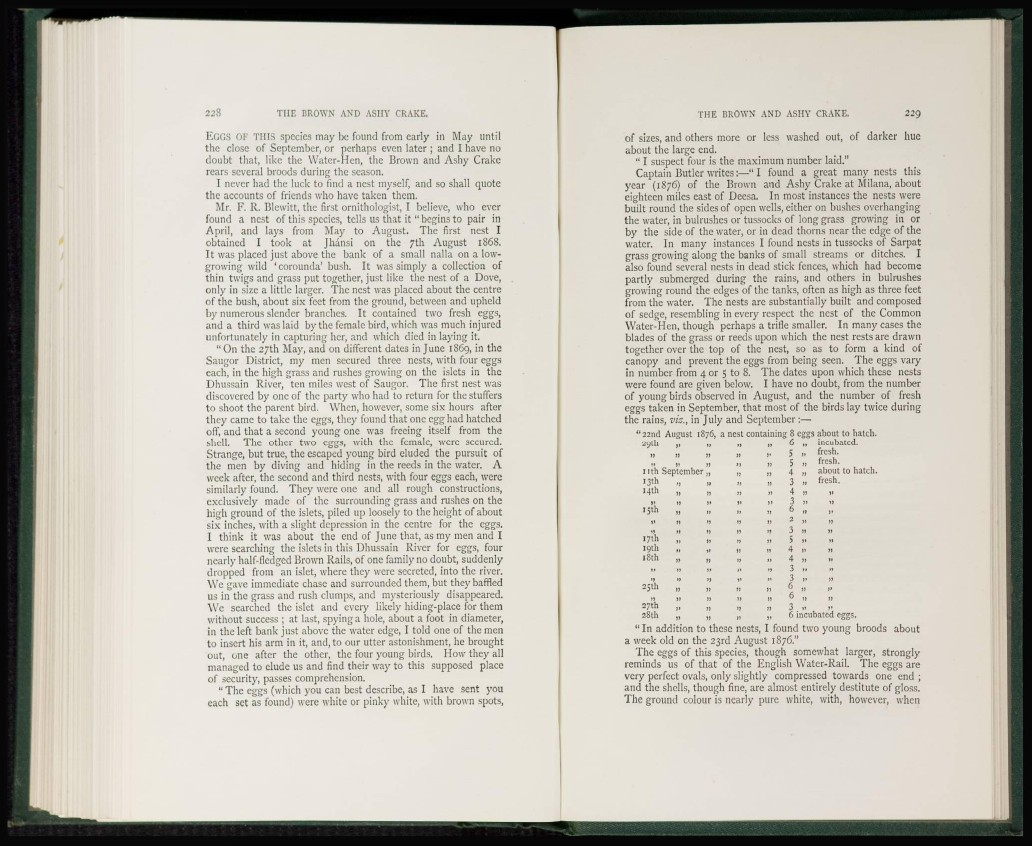
EGGS OF THIS species may be found from early in May until
the close of September, or perhaps even later ; and I have no
doubt that, like the Water-Hen, the Brown and Ashy Crake
rears several broods during the season.
I never had the luck to find a nest myself, and so shall quote
the accounts of friends who have taken them.
Mr. F. R. Blewitt, the first ornithologist, I believe, who ever
found a nest of this species, tells us that it " begins to pair in
April, and lays from May to August. The first nest I
obtained I took at Jhansi on the 7th August 1868.
It was placed just above the bank of a small nalla on a lowgrowing
wild ' corounda' bush. It was simply a collection of
thin twigs and grass put together, just like the nest of a Dove,
only in size a little larger. The nest was placed about the centre
of the bush, about six feet from the ground, between and upheld
by numerous slender branches. It contained two fresh eggs,
and a third was laid by the female bird, which was much injured
unfortunately in capturing her, and which died in laying it.
" On the 27th May, and on different dates in June 1869, in the
Saugor District, my men secured three nests, with four eggs
each, in the high grass and rushes growing on the islets in the
Dhussain River, ten miles west of Saugor. The first nest was
discovered by one of the party who had to return for the staffers
to shoot the parent bird. When, however, some six hours after
they came to take the eggs, they found that one egg had hatched
off, and that a second young one was freeing itself from the
shell. The other two eggs, with the female, were secured.
Strange, but true, the escaped young bird eluded the pursuit of
the men by diving and hiding in the reeds in the water. A
week after, the second and third nests, with four eggs each, were
similarly found. They were one and all rough constructions,
exclusively made of the surrounding grass and rushes on the
high ground of the islets, piled up loosely to the height of about
six inches, with a slight depression in the centre for the eggs.
I think it was about the end of June that, as my men and I
were searching the islets in this Dhussain River for eggs, four
nearly half-fledged Brown Rails, of one family no doubt, suddenly
dropped from an islet, where they were secreted, into the river.
We gave immediate chase and surrounded them, but they baffled
us in the grass and rush clumps, and mysteriously disappeared.
We searched the islet and every likely hiding-place for them
without success ; at last, spying a hole, about a foot in diameter,
in the left bank just above the water edge, I told one of the men
to insert his arm in it, and, to our utter astonishment, he brought
out, one after the other, the four young birds. How they all
managed to elude us and find their way to this supposed place
of security, passes comprehension.
" The eggs (which you can best describe, as I have sent you
each set as found) were white or pinky white, with brown spots,
of sizes, and others more or less washed out, of darker hue
about the large end.
" I suspect four is the maximum number laid."
Captain Butler writes:—•" I found a great many nests this
year (1876) of the Brown and Ashy Crake at Milana, about
eighteen miles east of Decsa. In most instances the nests were
built round the sides of open wells, either on bushes overhanging
the water, in bulrushes or tussocks of long grass growing in or
by the side of the water, or in dead thorns near the edge of the
water. In many instances I found nests in tussocks of Sarpat
grass growing along the banks of small streams or ditches. I
also found several nests in dead stick fences, which had become
partly submerged during the rains, and others in bulrushes
growing round the edges of the tanks, often as high as three feet
from the water. The nests are substantially built and composed
of sedge, resembling in every respect the nest of the Common
Water-Hen, though perhaps a trifle smaller. In many cases the
blades of the grass or reeds upon which the nest rests are drawn
together over the top of the nest, so as to form a kind of
canopy and prevent the eggs from being seen. The eggs vary
in number from 4 or 5 to 8. The dates upon which these nests
were found are given below. I have no doubt, from the number
of young birds observed in August, and the number of fresh
eggs taken in September, that most of the birds lay twice during
the rains, viz., in July and September :—
"22nd August 1876, a nest containing 8 eggs about to hatch.
29th
»» »T 11
1 tth September „
13th „
' 4 * 11 »
1 5 *
17th
19th
18th
25th
»I
27th
28th
incubated,
fresh,
fresh.
about to hatch,
fresh.
6 incubated eggs.
"In addition to these nests, I found two young broods about
a week old on the 23rd August 1876."
The eggs of this species, though somewhat larger, strongly
reminds us of that of the English Water-Rail. The eggs are
very perfect ovals, only slightly compressed towards one end ;
and the shells, though fine, are almost entirely destitute of gloss.
The ground colour is nearly pure white, with, however, when